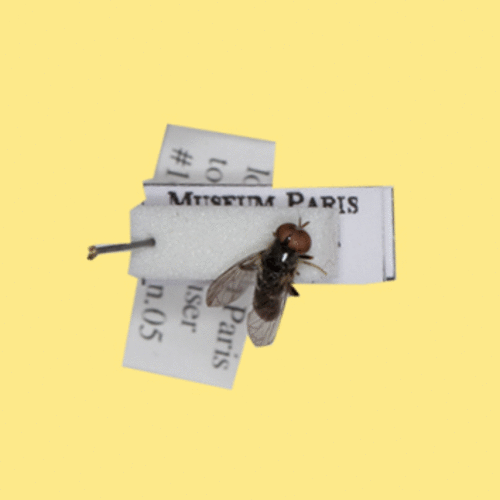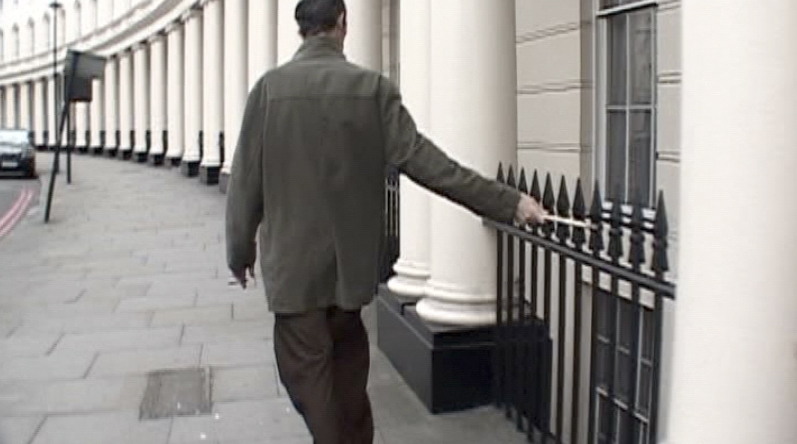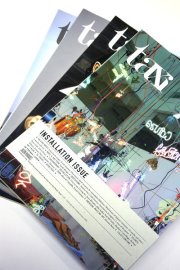
© » KADIST
Pierre Gonnord
Nakayama is part of a larger body of work by Pierre Gonnord focusing on the analysis and description of the lifestyles of urban youth in large Western cities. These images reflect on new canons of beauty, and the appearances and simulacra of fashion for a new generation. In particular, these works consider themes of androgyny, crossbreeding, and recycling.

© » KADIST
Pierre Gonnord
Bimba y Delfin is part of a larger body of work by Pierre Gonnord focusing on the analysis and description of the lifestyles of urban youth in large Western cities. These images reflect on new canons of beauty, and the appearances and simulacra of fashion for a new generation. In particular, these works consider themes of androgyny, crossbreeding, and recycling.

© » KADIST
Liu Yujia
Black Ocean by Liu Yujia portrays a desert landscape in a state of both destruction and construction, revealing the desert’s simultaneous fragility and indestructibility. The structure of the storytelling of this film was inspired by Italian writer Italo Calvino’s novel, Invisible Cities (1972). Several chapters from the book are interwoven in the film incorporating the discussions of cities and landscapes narrated by Marco Polo and Kublai Khan in the novel.

© » KADIST
Mohammed Kazem
“Untitled” was filmed in Bodh Gaya, India during a residency in 2011. There, he came across a scene that appealed to his interest in the political and social aspects of modernity. He filmed a policeman who, seemingly, is controlling traffic.

© » KADIST
Yosuke Takeda
Yosuke Takeda gives the viewer brightly colored views, each of which he has searched out and patiently waited for. He gives light a density in the precise moments he captures—a forest’s leaves shimmering in the early morning, a street’s reflective surface radiating color at night, luminous blinds drawn over an apartment window. He achieves his distinctive effects by using an old, second hand analog-era lens that he attaches to his digital camera.

© » KADIST
Marlon de Azambuja
Following a series of related works, Brutalismo Americano by Marlon de Azambuja is a site-specific sculptural installation produced during the artist’s residency at Kadist, San Francisco in 2017. Treating the city as an object of attention, de Azambuja collected building materials from the surrounding area over a period of ten days to conceive of an architecture in situ. The work is not meant to mimic any of San Francisco’s own architecture, or to be a maquette or portrait of the cityscape, but instead a singular, constructive gesture.
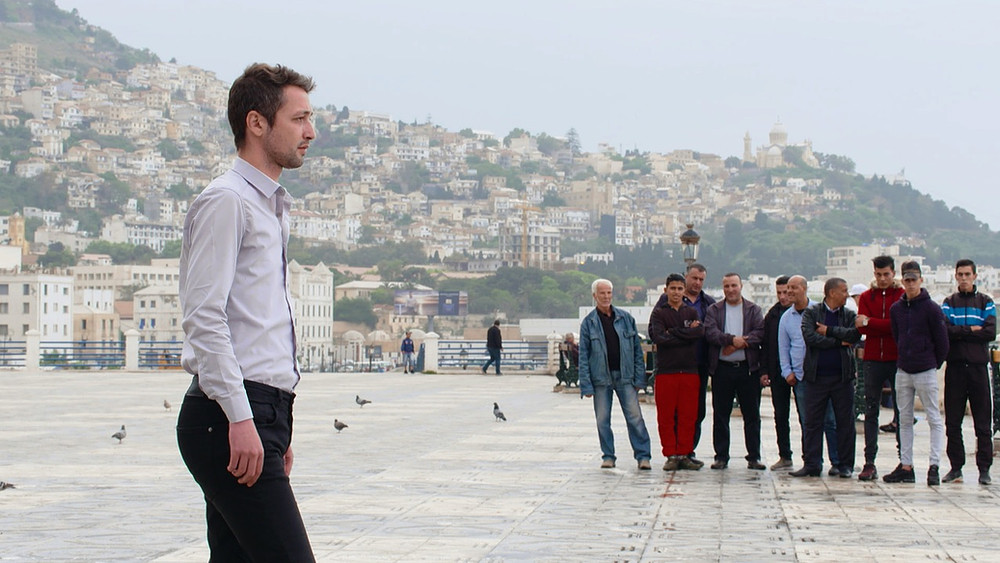
© » KADIST
Carole Douillard & Babette Mangolte
Following Bruce Nauman’s seminal performance Walking in an Exaggerated Manner Around the Perimeter of a Square (1967) – which sees the artist carefully trace a small delimited area of his studio exaggerating the movements of his hips as he places one foot in front of the other – Idir reproduces these performative gestures in Algiers, Algeria. Idir continues the artist’s previous work on ‘hittistes’, which translates as someone who spends their day with their back to the wall, the city’s unemployed and the gestures proper to them. In collaboration with cinematographer Babette Mangolte, Carole Douillard’s performance takes place across three emblematic sites within the city: Bab El Oued, Les Sablettes and Diar Es Saâda.

© » KADIST
Yuji Agematsu
Each day, Yuji Agematsu smokes a pack of cigarettes and wanders the streets of New York City looking for trash. Needless to say, he finds it everywhere: bottle caps, gummed hair, translucent miscellany, sick feathers, hot pink plastics, unknown, and more. The varied bits are then constellated by the artist in cellophane cigarette wrappers—modest vitrines for his steady collecting habit.
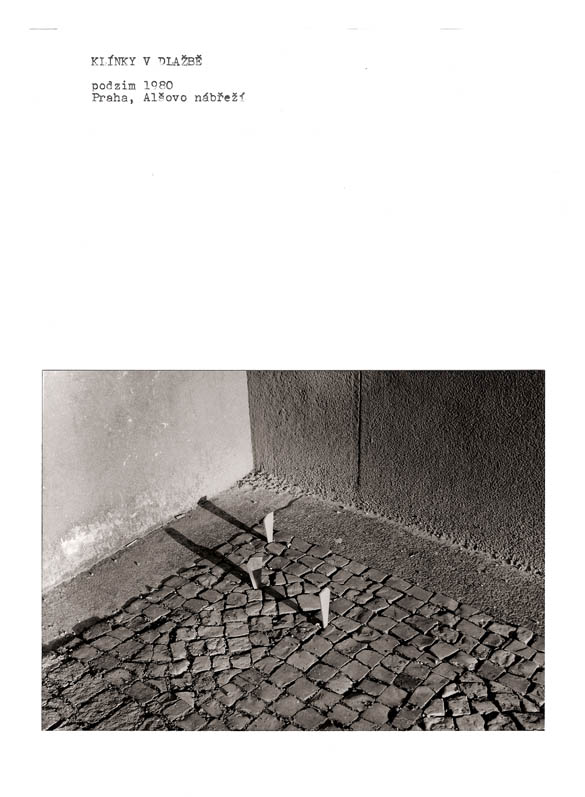
© » KADIST
Jiri Kovanda
Kovanda’s street interventions are always documented according to the same format as the actions: a piece of A4 paper, a typewritten text giving a precise location and date, and a photograph. Contrarily to the actions, he took the photographs himself. One of the rules he stuck to in his artistic practice was to always use material at his disposal, a real economy of means.

© » KADIST
Mohamed Bourouissa
After seeing Martha Camarillo’s photographs of horsemen in Strawberry Mansion -an impoverished Philadelphia neighbourhood- Mohamed Bourouissa travelled to see the urban stables run by African American men. For eight months, he observed, drew and photographed this community. As the community and Bourouissa became closer throughout his stay, the artist suggested that they organize a competition, called “Horse Day”, in which artists from other neighborhoods would be invited to create costumes for the horses.

© » KADIST
Valérie Jouve
Like many contemporary photographers who play with the codes of realism, Valérie Jouve composes her images, having already a more or less predetermined result in mind, in order to deliver a complex representation of the world instead of a bold presentation of facts. A part of the series “Les Figures”, this “portrait’ of P. Faure carries a strong ambiguity, typical of the photographer’s images, between realism and mise-en-scene . This photograph is exemplary of Valérie Jouve’s work: inscription of an inidual within an urban landscape, relation to architecture, simplicity of composition and strong, yet imprecise narrativity – related in part to seemingly familiar characters or places.

© » KADIST
Claudia Gutiérrez
The title for this body of work, Poco se gana hilando, pero menos mirando , is based on a Spanish saying that underestimates feminized crafts or tasks, implying that it is better for a woman to be doing ‘something’, no matter how useless it is, instead of just doing nothing. This series of works by Claudia Gutiérrez Marfull features embroideries that represent the peripheral and marginalized landscapes of Puente Alto commune in Santiago, the city’s biggest district and its most southern outskirts. In 2015, when this work was produced, there was not a single health service provider, police station, pharmacy, daycare or school in the whole area of Puente Alto.

© » KADIST
Jiri Kovanda
Kovanda’s street interventions are always documented according to the same format as the actions: a piece of A4 paper, a typewritten text giving a precise location and date, and a photograph. Contrarily to the actions, he took the photographs himself. One of the rules he stuck to in his artistic practice was to always use material at his disposal, a real economy of means.

© » KADIST
Ryan Villamael
Behold A City 4 extols the old grandeur of Manila, the nation’s storied capital – the complex nexus of heritage, modernity, and all sorts of compulsions, political or otherwise, that attempt to define it. This is not Manila whittled down to a scale model but a re-imagination of the city by Ryan Villamael in his ardor to approximate its complexity both as a physical, urban fact and an evolving concept. Behold A City 4 features an entirely new topography and arrangement.

© » KADIST
Jiri Kovanda
This ephemeral installation by Jirí Kovanda, documented in the same way as his performances with a photograph and a text, belongs to a body of works that took place in his apartment/studio. During an interview with Hans Ulrich Obrist, the artist highlighted that he had never had a studio and that this work space blended with his apartment. A piece of string cuts across the room in a diagonal; it functions as a scale to measure time and space.

© » KADIST
John Gerrard
Flag (Thames) 2016 depicts a small section of the Thames River—one that is adjacent to the Palace of Westminster in London—as an algorithmic representation on an LED panel. The river color is vividly represented with reflections of buildings along the riverbank, including Big Ben. At the center of the scene sits a simulated gasoline spill.

© » KADIST
Marcelo Cidade
Marcelo Cidade interrogates the city, architecture and urban planning. This architectonic drawing proposes modular possibilities, adaptable variations based on the form of the concrete block (a material which is often actually integrated in his practice). The “re-definition” announced in the title is in construction, in process, under development, in flux.
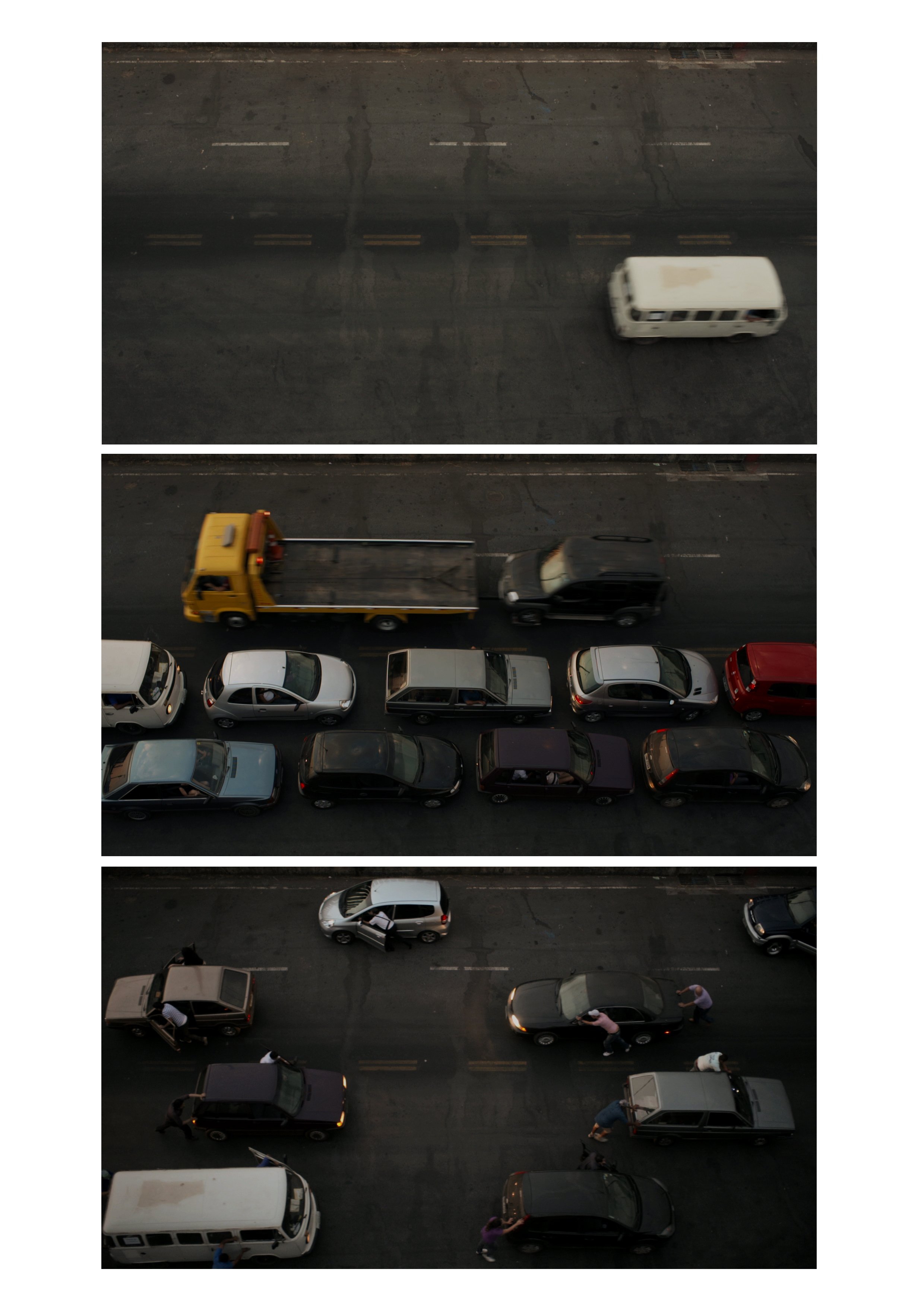
© » KADIST
Cinthia Marcelle
Cinthia Marcelle’s video work Automóvel (2012) re-edits the mundane rhythms of automotive traffic into a highly compelling and seemingly choreographed meditation on sequence, motion, and time. Shot from an aerial vantage, the camera tracks the daily commute on a small stretch of concrete highway. The camera films the traffic below in short five-second excerpts before blacking out; time begins to collapse as the video shifts between scene, and the hours compress into minutes as daylight quickly turns into night.
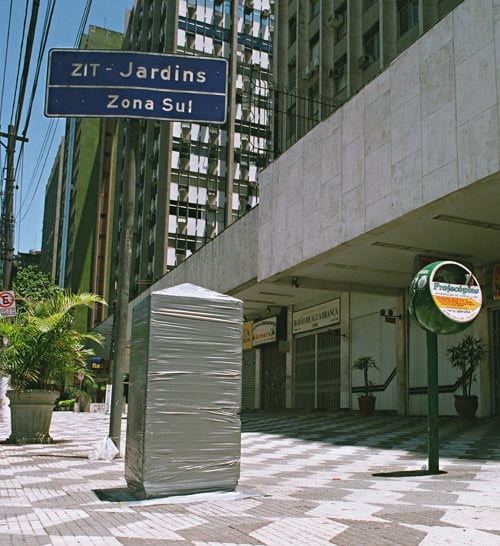
© » KADIST
Marcelo Cidade
This series of photographs reflects Marcelo Cidade’s incessant walks or drifting through the city and his chance encounters with a certain street poetry like the Surrealists or Situationists before him. He captures incongruities or everyday simplicity and highlights their suggestive power. The composition and framing of these interventions specially emphasizes the object of interest and the humor of the context.
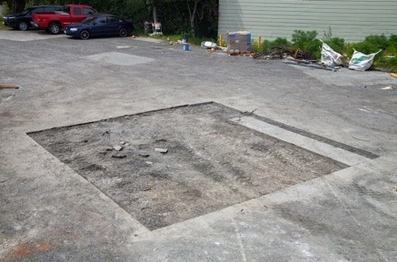
© » KADIST
Marcelo Cidade
450 Hayes Street (excavation site) by Marcelo Cidade is a large scale photograph documenting the artist’s excavation of a parking lot located at 450 Hayes Street in San Francisco, a former section of the city’s Central freeway and current condominium site. The cut shape mirrors the precise shape of the Kadist gallery floor, where the concrete was relocated as part of his residency exhibition entitled Somewhere, Elsewhere, Anywhere, Nowhere. Through this concrete graft, Cidade inextricably links the city with artwork.

© » KADIST
J. John Priola
Priola pays particular attention to otherwise unnoticed details in the cityscape, a quality that not only recurs throughout his oeuvre, but which also places his work in line with a strong tradition of California documentary photography. Close-ups and attention to detail reveal something different: a portrait of what is usually discarded or missing, like unassuming weep holes in Alameda Street or minuscule weeds making their way up through the pavement in Chestnut Street . But these details are subtle to the point of being conceptual; from afar both images appear to be monochromes.
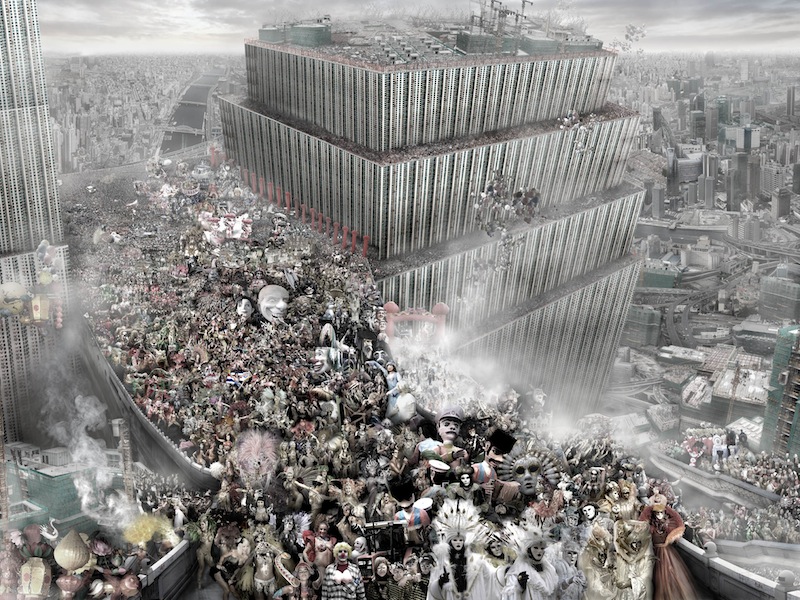
© » KADIST
Du Zhenjun
The Tower of Babel is an installation of large-format photographs that forces the audience to occupy a central position through its monumental scale. These photographs present a series of urban landscapes and assembled Foucauldian structures of the present. Du sees the Tower of Babel as a continually reinvented narrative that warns people of “dangerous tendencies in the present time.” Du’s Babylonian towers resurrect from fallen rubbles of religious history in grand scale to focus on modern crises of civilization.

© » KADIST
Ian Wallace
Wallace says of his Heroes in the Street series, “The street is the site, metaphorically as well as in actuality, of all the forces of society and economics imploded upon the individual, who, moving within the dense forest of symbols of the modern city, can achieve the status of the heroic.” The hero in Study for my Heroes in the Street (Stan) is the photoconceptual artist Stan Douglas, who is depicted here (and also included in the Kadist Collection) as an archetypal figure restlessly drifting the streets of the modern world. Patches of canvas cover parts of this otherwise representational photograph and ask the viewer to consider the role that editing and play in our perception of the urban landscape and modernity.

© » KADIST
Alessandro Balteo Yazbeck
Part of a larger series of photographic works, Alessandro Balteo Yazbeck’s Corrupted file from page 14 (V1) from the series La Vega, Plan Caracas No. 1, 1974-1976 presents an interrupted image. The images capture scenes from an urban development, La Vega, built to modernize and connect favelas in Venezuela.

© » KADIST
Lin Yilin
Golden Bridge is part of “Golden Journey”, a series of site-specific performances and installations created during Lin’s residency at Kadist San Francisco. The photograph is a documentation of a Golden Gate Bridge performance that makes palpable the tensions between people and the military, the individual and the group, danger and ordinary life. Lin recalls: “Fighter planes repetitively flew over my head.

© » KADIST
Heman Chong
The work Calendars is composed of 1001 images of deserted public areas in Singapore printed on pages of a calendar set from the year of 2020 until 2096. Yet Chong photographed these public spaces (shopping centers, museums, MRT stations and schools) between 2004 and 2010. Calendars continues Hong’s conceptual investigation of the intersections between time, space and situation.

© » KADIST
Catherine Opie
Although best known as a provocateur and portraitist, Opie also photographs landscapes, cityscapes, and architecture. The Freeway Series was developed in 1995, right after the artist’s inclusion in that year’s Whitney Biennial. As if suggesting that her work should not be restricted to being seen through overtly political or activist lenses, this series lends insight into the city of Los Angeles via its most characteristic urban feature: its highways.
Jiri Kovanda
- location: Praha, Ceská Republika
- year born: 1953
- gender: male
- nationality: Czech
Du Zhenjun
- location: Paris, France
- location: Shanghai, China
- year born: 1961
- gender: male
- nationality: Chinese
- home town: Shanghai, China
Pierre Gonnord
Pierre Gonnord is known for his large scale photographic portraits of people who inhabit the fringes of society...
Yosuke Takeda
Yosuke Takeda started from experimenting with darkroom photography production and he shifted over to digital photography, aware that photographic film and paper were becoming obsolete...
Ian Wallace
- year born: 1943
- gender: male
- nationality: British
- home town: Shoreham, United Kingdom
Cinthia Marcelle
- location: Belo Horizonte, Brazil
- year born: 1974
- gender: female
- nationality: Brazilian
- home town: Belo Horizonte, Brazil
Clarissa Tossin
- location: Los Angeles, California
- year born: 1973
- gender: female
- nationality: Brazilian
- home town: Porto Alegre, Brazil
Carole Douillard & Babette Mangolte
Carole Douillard Kabyle-French artist Carole Douillard uses the presence of figures, be it her own, or of performers, to produce sculptural works within space...
Heman Chong
- year born: 1977
- gender: male
- nationality: Singaporean
- home town: Muar, Malaysia
John Gerrard
For more than two decades, John Gerrard has produced media work that has harnessed the emergent technologies of programming languages and gaming engines, and transmuted them into landscapes and portraits of ever increasing intricacy and autonomy...
Ryan Villamael
Ryan Villamael’s deeply layered practice is informed by a rare degree of skill and dexterity as well as by vivid imagination and haunting intellectual preoccupations...
Mohammed Kazem
Mohammed Kazem (b...
Marlon de Azambuja
Based on ideas of architecture, and by means of appropriation of public space and studio-based material operations, Marlon de Azambuja’s work creates new idioms for thinking and inhabiting the built environment...
Cici Wu
Beijing-born artist Cici Wu is a cultural nomad whose work takes on unusual forms, from functional sculptures to haphazard installations featuring delicate jerry-rigged parts, including for example: a stepper motor, belt, pulley, light sensor, sleeves, silicone, silver chain, dried strawberry leaves, and a video...
Abraham Cruzvillegas
- location: Mexico
- year born: 1968
- gender: male
- nationality: Mexican
- home town: Mexico City, Mexico
Alessandro Balteo Yazbeck
- location: Berlin, Germany
- year born: 1972
- gender: male
- nationality: Venezuelan
- home town: Caracas, Venezuela
Catherine Opie
- location: Los Angeles, California
- year born: 1961
- gender: female
- nationality: American
- home town: Sandusky, Ohio
Liu Yujia
Artist Liu Yujia’s practice revolves mainly around video and photography...
J. John Priola
In his characteristic black-and-white gelatin silver prints, San Franicisco-based J...
Maria Taniguchi
Throughout her paintings, sculptures, and videos, Maria Taniguchi unpacks knowledge and experience—connecting material culture, technology, and natural evolution—and investigates space and time, along with social and historical contexts...
Tsang Eason Ka Wai
Working primarily with photography, but more recently with video and lightboxes, Eason Tsang Ka takes inspiration from the urban density of Hong Kong as well as from everyday objects....
Lin Yilin
- location: Beijing & New York
- year born: 1964
- gender: male
- nationality: Chinese
- home town: Guangzhou, China
Juan Araujo
- year born: 1971
- gender: male
- nationality: Spanish
- home town: Caracas, Venezuela
Mohamed Bourouissa
Mohamed Bourouissa became known in the 2000s with a series of photographs on young people in the suburbs of Paris...
Yuji Agematsu
Yuji Agematsu is an artist who works across various media, including sound, photography, and the arrangements of objects—not exactly sculpture...
-
1970-1979
Jiri Kovanda
1979This ephemeral installation by Jirí Kovanda, documented in the same way as his performances with a photograph and a text, belongs to a body of works that took place in his apartment/studio...
-
1980-1989
Jiri Kovanda
1980Kovanda’s street interventions are always documented according to the same format as the actions: a piece of A4 paper, a typewritten text giving a precise location and date, and a photograph...
Jiri Kovanda
1980Kovanda’s street interventions are always documented according to the same format as the actions: a piece of A4 paper, a typewritten text giving a precise location and date, and a photograph...
Ian Wallace
1986Wallace says of his Heroes in the Street series, “The street is the site, metaphorically as well as in actuality, of all the forces of society and economics imploded upon the individual, who, moving within the dense forest of symbols of the modern city, can achieve the status of the heroic.” The hero in Study for my Heroes in the Street (Stan) is the photoconceptual artist Stan Douglas, who is depicted here (and also included in the Kadist Collection) as an archetypal figure restlessly drifting the streets of the modern world...
-
1990-1999
Catherine Opie
1994Although best known as a provocateur and portraitist, Opie also photographs landscapes, cityscapes, and architecture...
-
2000-2009
Valérie Jouve
2000Like many contemporary photographers who play with the codes of realism, Valérie Jouve composes her images, having already a more or less predetermined result in mind, in order to deliver a complex representation of the world instead of a bold presentation of facts...
Pierre Gonnord
2002Nakayama is part of a larger body of work by Pierre Gonnord focusing on the analysis and description of the lifestyles of urban youth in large Western cities...
Marcelo Cidade
2006This series of photographs reflects Marcelo Cidade’s incessant walks or drifting through the city and his chance encounters with a certain street poetry like the Surrealists or Situationists before him...
J. John Priola
2008Priola pays particular attention to otherwise unnoticed details in the cityscape, a quality that not only recurs throughout his oeuvre, but which also places his work in line with a strong tradition of California documentary photography...
Alessandro Balteo Yazbeck
2008Part of a larger series of photographic works, Alessandro Balteo Yazbeck’s Corrupted file from page 14 (V1) from the series La Vega, Plan Caracas No...
-
2010-2019
Yosuke Takeda
2010Yosuke Takeda gives the viewer brightly colored views, each of which he has searched out and patiently waited for...
Du Zhenjun
2010The Tower of Babel is an installation of large-format photographs that forces the audience to occupy a central position through its monumental scale...
Du Zhenjun
2010The Tower of Babel is an installation of large-format photographs that forces the audience to occupy a central position through its monumental scale...
Cinthia Marcelle
2012Cinthia Marcelle’s video work Automóvel (2012) re-edits the mundane rhythms of automotive traffic into a highly compelling and seemingly choreographed meditation on sequence, motion, and time...
Heman Chong
2012The work Calendars is composed of 1001 images of deserted public areas in Singapore printed on pages of a calendar set from the year of 2020 until 2096...
Clarissa Tossin
2012In Fordlândia Fieldwork (2012), Tossin documents the remains of Henry Ford’s rubber enterprise Fordlândia, built in 1928 in the Brazilian Amazon to export cultivated rubber for the booming automobile industry...
Maria Taniguchi
2012Untitled (Celestial Motors) is a visual meditation on an icon of modern urban Philippine life—the jeepney...
Mohamed Bourouissa
2013After seeing Martha Camarillo’s photographs of horsemen in Strawberry Mansion -an impoverished Philadelphia neighbourhood- Mohamed Bourouissa travelled to see the urban stables run by African American men...
Marcelo Cidade
2014450 Hayes Street (excavation site) by Marcelo Cidade is a large scale photograph documenting the artist’s excavation of a parking lot located at 450 Hayes Street in San Francisco, a former section of the city’s Central freeway and current condominium site...
Yuji Agematsu
2015Each day, Yuji Agematsu smokes a pack of cigarettes and wanders the streets of New York City looking for trash...
Claudia Gutiérrez
2016The title for this body of work, Poco se gana hilando, pero menos mirando , is based on a Spanish saying that underestimates feminized crafts or tasks, implying that it is better for a woman to be doing ‘something’, no matter how useless it is, instead of just doing nothing...
John Gerrard
2016Flag (Thames) 2016 depicts a small section of the Thames River—one that is adjacent to the Palace of Westminster in London—as an algorithmic representation on an LED panel...
Marlon de Azambuja
2017Following a series of related works, Brutalismo Americano by Marlon de Azambuja is a site-specific sculptural installation produced during the artist’s residency at Kadist, San Francisco in 2017...
Carole Douillard & Babette Mangolte
2018Following Bruce Nauman’s seminal performance Walking in an Exaggerated Manner Around the Perimeter of a Square (1967) – which sees the artist carefully trace a small delimited area of his studio exaggerating the movements of his hips as he places one foot in front of the other – Idir reproduces these performative gestures in Algiers, Algeria...
Ryan Villamael
2019Behold A City 4 extols the old grandeur of Manila, the nation’s storied capital – the complex nexus of heritage, modernity, and all sorts of compulsions, political or otherwise, that attempt to define it...
























